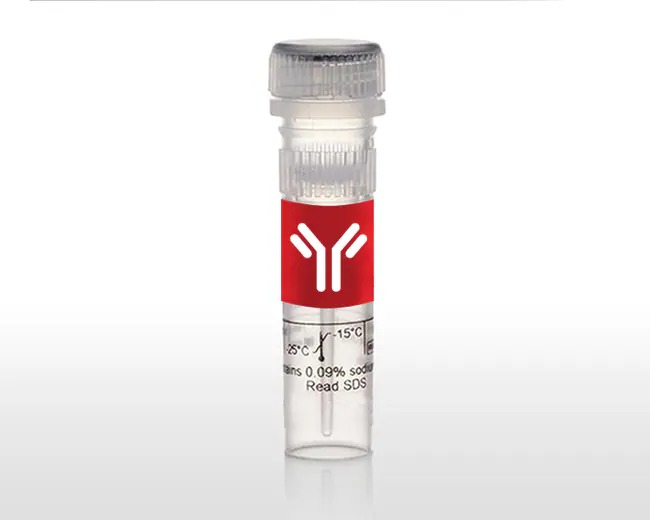Invitrogen™ beta-Catenin Recombinant Rabbit Monoclonal Antibody (6A3P2), 100 µL
Catalog No :
CAS Number :
Brand :
In Stock
Specifications:
| Application | Western Blot, immunocytochemistry, ELISA-Based Assays, Immunohistochemistry, Immunoprecipitation (IP) | ||
| Storage Temperature | -20°C | ||
| Product Type | antibody | Forms | Liquid |
| Product Brand | Thermo Fisher Scientific™ | ||
| Product Grade | Molecular Biology | ||
The Invitrogen™ Beta-Catenin Recombinant Rabbit Monoclonal Antibody (6A3P2) is a highly specific and validated antibody designed for detecting beta-catenin (CTNNB1) in human, mouse, and rat samples. This antibody is produced using HEK293 cell expression systems, ensuring high specificity, sensitivity, and lot-to-lot consistency. It has been verified through knockdown experiments to confirm its binding specificity to beta-catenin.
Beta-catenin is a key component of the Wnt signaling pathway and plays a crucial role in cell adhesion, gene transcription regulation, and cancer progression. It interacts with cadherins and catenins to regulate epithelial cell integrity, and its dysregulation has been implicated in colorectal cancer, breast cancer, and other malignancies.
Applications & Recommended Dilutions
This antibody is optimized for multiple applications in Western blot, immunohistochemistry, immunocytochemistry, ELISA, and immunoprecipitation:
- Western Blot (WB):
- Recommended dilution: 1:500 - 1:1,000
- Used to detect beta-catenin protein levels in cell and tissue lysates.
- Immunohistochemistry (Paraffin) (IHC-P):
- Recommended dilution: 1:50 - 1:200
- Enables detection of beta-catenin expression in paraffin-embedded tissue samples.
- Immunocytochemistry / Immunofluorescence (ICC/IF):
- Recommended dilution: 1:50 - 1:200
- Used for localizing beta-catenin in fixed cells.
- Enzyme-Linked Immunosorbent Assay (ELISA):
- Recommended concentration: 1 µg/mL
- Suitable for quantitative beta-catenin detection.
- Immunoprecipitation (IP):
- Recommended concentration: 0.5 µg - 4 µg per 400 µg - 600 µg of protein extract
- Facilitates pull-down of beta-catenin protein complexes.
Product Specifications
| Feature | Details |
|---|---|
| Species Reactivity | Human, Mouse, Rat |
| Host / Isotype | Rabbit / IgG |
| Expression System | HEK293 cells |
| Class | Recombinant Monoclonal |
| Type | Antibody |
| Clone | 6A3P2 |
| Immunogen | Synthetic peptide (aa 1-100) of human beta-catenin (P35222) |
| Conjugate | Unconjugated |
| Form | Liquid |
| Concentration | 1 mg/mL |
| Purification | Affinity Chromatography |
| Storage Buffer | PBS, pH 7.3, with 50% glycerol, 0.05% BSA |
| Preservative | 0.05% ProClin 300 |
| Storage Conditions | -20°C (Avoid freeze/thaw cycles) |
| Shipping Conditions | Wet Ice |
| RRID | AB_2848867 |
Scientific Background: Beta-Catenin (CTNNB1)
Beta-catenin is a multifunctional protein involved in cell adhesion, Wnt signaling, and tumorigenesis. It is a cadherin-associated protein that links E-cadherin to the cytoskeleton, stabilizing cell-cell junctions in epithelial tissues. Additionally, beta-catenin serves as a transcriptional co-activator in the Wnt signaling pathway, where it regulates genes involved in proliferation and differentiation.
Functions of Beta-Catenin:
- Regulates cell adhesion through interactions with E-cadherin and α-catenin.
- Mediates Wnt signaling by translocating to the nucleus and activating gene expression.
- Promotes transcription of oncogenes such as c-myc and cyclin D1, driving tumor progression.
- Interacts with APC (Adenomatous Polyposis Coli) protein in colorectal cancer development.
- Overexpression or mutation leads to cancers such as colorectal, breast, ovarian, and prostate cancers.
Beta-Catenin in Cancer Research
- Mutations in the CTNNB1 gene are frequently observed in colorectal cancer, hepatocellular carcinoma, and glioblastomas.
- Loss of beta-catenin regulation disrupts cell adhesion and promotes EMT (epithelial-to-mesenchymal transition), leading to tumor invasion and metastasis.
- Aberrant nuclear localization of beta-catenin serves as a biomarker for aggressive tumors.
Chromosomal Location
- Human: CTNNB1 gene located on chromosome 3p22.1.
- Mouse: Ctnnb1 gene on chromosome 9.
- Rat: Ctnnb1 gene on chromosome 8.
Applications in Research
- Cancer Research & Tumor Biology
- Investigating beta-catenin mutations and expression in tumors.
- Studying Wnt signaling activation and nuclear translocation.
- Cell Adhesion & Morphogenesis
- Understanding beta-catenin’s role in epithelial integrity and tissue formation.
- Examining cell migration and invasion mechanisms.
- Stem Cell & Developmental Biology
- Exploring beta-catenin’s role in embryonic development and differentiation.
- Studying neuronal differentiation and organogenesis.
- Drug Development & Therapeutics
- Targeting beta-catenin for cancer drug screening.
- Evaluating Wnt pathway inhibitors.
Recommended Secondary Antibodies for IHC, WB, and ICC
For optimal detection in Western blot (WB), immunohistochemistry (IHC-P), and immunocytochemistry (ICC/IF), the following Invitrogen secondary antibodies are recommended:
| Catalog # | Product | Conjugate | Unit Size | |
|---|---|---|---|---|
| 31458 | Donkey anti-Rabbit IgG (H+L) Cross-Adsorbed | HRP | 500 µL | |
| A11008 | Goat anti-Rabbit IgG (H+L) Cross-Adsorbed | Alexa Fluor™ 488 | 1 mg | |
| A11070 | F(ab')2-Goat anti-Rabbit IgG (H+L) Cross-Adsorbed | Alexa Fluor™ 488 | 500 µg | |
| A11046 | Goat anti-Rabbit IgG (H+L) Cross-Adsorbed | Alexa Fluor™ 350 | - | - |
| A32731 | Goat anti-Rabbit IgG (H+L) Highly Cross-Adsorbed | Alexa Fluor™ Plus 488 | - | - |
| A21207 | Donkey anti-Rabbit IgG (H+L) Highly Cross-Adsorbed | Alexa Fluor™ 594 | - | - |
| A10523 | Goat anti-Rabbit IgG (H+L) Cross-Adsorbed | Cyanine5 | - | - |
Storage & Stability
- Storage Temperature: -20°C (Avoid freeze/thaw cycles).
- Shipping Conditions: Wet ice for preservation.
The Invitrogen™ Beta-Catenin Recombinant Rabbit Monoclonal Antibody (6A3P2) is a high-specificity, recombinant monoclonal antibody designed for Western blot (WB), immunohistochemistry (IHC-P), immunocytochemistry (ICC/IF), ELISA, and immunoprecipitation (IP) applications. It is optimized for detecting beta-catenin across human, mouse, and rat samples, making it an essential tool for cancer research, Wnt signaling studies, and cell adhesion research.




 0
0
